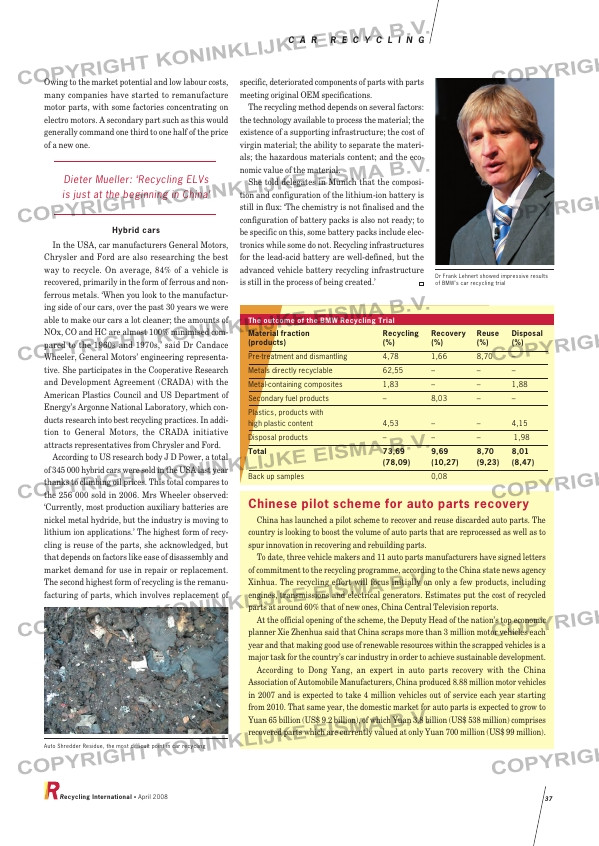Page 37 from: April 2008

Owing to the market potential and low labour costs,
many companies have started to remanufacture
motor parts, with some factories concentrating on
electro motors. A secondary part such as this would
generally command one third to one half of the price
of a new one.
Hybrid cars
In the USA, car manufacturers General Motors,
Chrysler and Ford are also researching the best
way to recycle. On average, 84% of a vehicle is
recovered, primarily in the form of ferrous and non-
ferrous metals. ‘When you look to the manufactur-
ing side of our cars, over the past 30 years we were
able to make our cars a lot cleaner; the amounts of
NOx, CO and HC are almost 100% minimised com-
pared to the 1960s and 1970s,’ said Dr Candace
Wheeler, General Motors’ engineering representa-
tive. She participates in the Cooperative Research
and Development Agreement (CRADA) with the
American Plastics Council and US Department of
Energy’s Argonne National Laboratory, which con-
ducts research into best recycling practices. In addi-
tion to General Motors, the CRADA initiative
attracts representatives from Chrysler and Ford.
According to US research body J D Power, a total
of 345 000 hybrid cars were sold in the USA last year
thanks to climbing oil prices. This total compares to
the 256 000 sold in 2006. Mrs Wheeler observed:
‘Currently, most production auxiliary batteries are
nickel metal hydride, but the industry is moving to
lithium ion applications.’ The highest form of recy-
cling is reuse of the parts, she acknowledged, but
that depends on factors like ease of disassembly and
market demand for use in repair or replacement.
The second highest form of recycling is the remanu-
facturing of parts, which involves replacement of
specific, deteriorated components of parts with parts
meeting original OEM specifications.
The recycling method depends on several factors:
the technology available to process the material; the
existence of a supporting infrastructure; the cost of
virgin material; the ability to separate the materi-
als; the hazardous materials content; and the eco-
nomic value of the material.
She told delegates in Munich that the composi-
tion and configuration of the lithium-ion battery is
still in flux: ‘The chemistry is not finalised and the
configuration of battery packs is also not ready; to
be specific on this, some battery packs include elec-
tronics while some do not. Recycling infrastructures
for the lead-acid battery are well-defined, but the
advanced vehicle battery recycling infrastructure
is still in the process of being created.’
C A R R E C Y C L I N G
Recycling International • April 2008 37
Chinese pilot scheme for auto parts recovery
China has launched a pilot scheme to recover and reuse discarded auto parts. The
country is looking to boost the volume of auto parts that are reprocessed as well as to
spur innovation in recovering and rebuilding parts.
To date, three vehicle makers and 11 auto parts manufacturers have signed letters
of commitment to the recycling programme, according to the China state news agency
Xinhua. The recycling effort will focus initially on only a few products, including
engines, transmissions and electrical generators. Estimates put the cost of recycled
parts at around 60% that of new ones, China Central Television reports.
At the official opening of the scheme, the Deputy Head of the nation’s top economic
planner Xie Zhenhua said that China scraps more than 3 million motor vehicles each
year and that making good use of renewable resources within the scrapped vehicles is a
major task for the country’s car industry in order to achieve sustainable development.
According to Dong Yang, an expert in auto parts recovery with the China
Association of Automobile Manufacturers, China produced 8.88 million motor vehicles
in 2007 and is expected to take 4 million vehicles out of service each year starting
from 2010. That same year, the domestic market for auto parts is expected to grow to
Yuan 65 billion (US$ 9.2 billion), of which Yuan 3.8 billion (US$ 538 million) comprises
recovered parts which are currently valued at only Yuan 700 million (US$ 99 million).
The outcome of the BMW Recycling Trial
Material fraction Recycling Recovery Reuse Disposal
(products) (%) (%) (%) (%)
Pre-treatment and dismantling 4,78 1,66 8,70 –
Metals directly recyclable 62,55 – – –
Metal-containing composites 1,83 – – 1,88
Secondary fuel products – 8,03 – –
Plastics, products with
high plastic content 4,53 – – 4,15
Disposal products – – – 1,98
Total 73,69 9,69 8,70 8,01
(78,09) (10,27) (9,23) (8,47)
Back up samples 0,08
Dr Frank Lehnert showed impressive results
of BMW’s car recycling trial
Auto Shredder Residue, the most difficult point in car recycling
Dieter Mueller: ‘Recycling ELVs
is just at the beginning in China’
RI_028 (IARC) Car recycling:Opmaak 1 03-04-2008 15:18 Pagina 37



